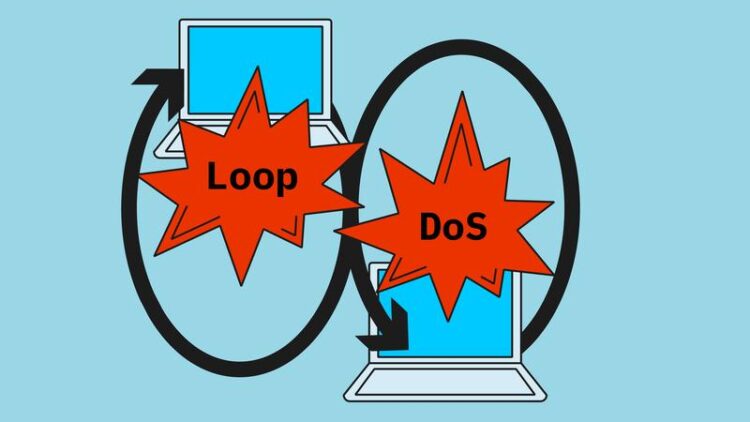Loop DoS: New Denial-of-Service Attack targets Application-Layer Protocols

Illustration "Application-Layer Loop DoS Attacks"
(c) CISPA
A new Denial-of-Service (DoS) attack targets application-layer protocols that draw on the User Datagram Protocol (UDP) for end-to-end communication. ‘Application-layer Loop DoS Attacks’ pair servers of these protocols in such a way that they communicate with each other indefinitely. The vulnerability affects both legacy (e.g., QOTD, Chargen, Echo) and contemporary (e.g., DNS, NTP, and TFTP) protocols. Discovered by researchers of the CISPA Helmholtz-Center for Information Security, the attack puts an estimated 300,000 Internet hosts and their networks at risk.
The newly discovered DoS loop attack is self-perpetuating and targets application-layer messages. It pairs two network services in such a way that they keep responding to one another’s messages indefinitely. In doing so, they create large volumes of traffic that result in a denial of service for involved systems or networks. Once a trigger is injected and the loop set in motion, even the attackers are unable to stop the attack. Previously known loop attacks occurred on the routing layer of a single network and were limited to a finite number of loop iterations.
An estimated 300,000 Internet hosts can be abused
Discovered by CISPA researchers Yepeng Pan and Professor Dr. Christian Rossow, application-layer loop DoS attacks are likely to concern a total of 300,000 Internet hosts. So far, Pan and Rossow have confirmed vulnerabilities for TFTP, DNS and NTP implementations as well as for the six legacy protocols Daytime, Time, Active Users, Echo, Chargen and QOTD. These protocols are widely used to provide basic functionalities on the Internet. While NTP, for instance, allows for time synchronization between computers, DNS matches domain names to their corresponding IP addresses. TFTP enables the transmission of files without user authentication.
Attacks can be triggered from a single spoofing-capable host
Application-layer loop DoS attacks rely on IP spoofing and can be triggered from a single spoofing-capable host. “For instance, attackers could cause a loop involving two faulty TFTP servers by injecting one single, IP-spoofed error message. The vulnerable servers would then continue to send each other TFTP error messages, putting stress on both servers and on any network link between them”, Rossow explains. Pan stresses the novelty of this attack vector: “The application-level loops we discovered differ from known network-layer loops. Hence, existing packet lifetime checks employed at the network level are unable to interrupt application-layer loops.”
Easy to exploit
“As far as we know, this kind of attack has not yet been carried out in the field. It would, however, be easy for attackers to exploit this vulnerability if no action were taken to mitigate the risk”, Rossow says. In December 2023, Rossow and Pan disclosed their discovery to the affected vendors and a trusted operator community. The two CISPA researchers coordinated a plan for the publication of an attack-specific advisory and started a notification campaign together with The Shadowserver Foundation.
Starting March 19, 2024, the attack specific advisory will be accessible via https://cispa.saarland/group/rossow/Loop-DoS
Wissenschaftliche Ansprechpartner:
Prof. Dr. Christian Rossow
rossow@cispa.de
https://cispa.de/en/people/rossow
Media Contact
All latest news from the category: Information Technology
Here you can find a summary of innovations in the fields of information and data processing and up-to-date developments on IT equipment and hardware.
This area covers topics such as IT services, IT architectures, IT management and telecommunications.
Newest articles

NASA: Mystery of life’s handedness deepens
The mystery of why life uses molecules with specific orientations has deepened with a NASA-funded discovery that RNA — a key molecule thought to have potentially held the instructions for…

What are the effects of historic lithium mining on water quality?
Study reveals low levels of common contaminants but high levels of other elements in waters associated with an abandoned lithium mine. Lithium ore and mining waste from a historic lithium…

Quantum-inspired design boosts efficiency of heat-to-electricity conversion
Rice engineers take unconventional route to improving thermophotovoltaic systems. Researchers at Rice University have found a new way to improve a key element of thermophotovoltaic (TPV) systems, which convert heat…



